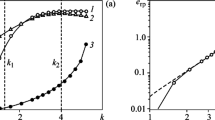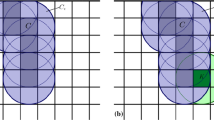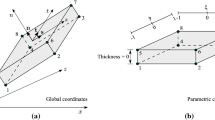Abstract
The initiation of a longitudinal shear crack (mode III fracture) in elastoplastic materials with the limiting strain is considered. The crack propagation criterion is formulated using a modified Leonov–Panasyuk–Dugdale model using an additional parameter—the width of the plasticity zone (the width of the pre-fracture zone). Conditions of a small-scale yielding in the presence of a stress field singularity in the vicinity of the crack tip are considered. A two-parameter criterion for quasi-brittle fracture of an elastoplastic material is formulated for mode III cracks. The proposed fracture criterion includes the deformation-based criterion, which is formulated at the crack tip, as well as the force-based criterion, formulated at the tip of a model crack. The lengths of the initial and model cracks differ by the length of the pre-fracture zone. The application of the proposed strength criterion to the determination of fracture loads for bodies containing longitudinal shear cracks is demonstrated. The diagrams of quasi-brittle fracture are constructed for a strip of finite width with an edge crack in case of the out-of-plane deformation. It is proposed to determine the model parameters using an idealized simple shear diagram and the critical stress intensity factor. For quasi-ductile and ductile types of fracture, the limiting loads are determined numerically. The propagation of plastic zones in the vicinity of the crack tip under quasistatic loading is successively described by the nonlinear finite element method. It is shown that the shapes of the numerically simulated plastic zones differ significantly from the known classical concepts.











Similar content being viewed by others
Abbreviations
- \( a \) :
-
Width of the pre-fracture zone
- \( a_{f} \) :
-
Width of the plasticity zone for full-scale yielding
- \( K_{\text{III}}^{{}} \) :
-
Stress intensity factor (SIF)
- \( K_{{{\text{III}}\infty }} \) :
-
SIF generated by stresses \( \tau_{\infty } \) applied to distant boundaries
- \( K_{{{\text{III}}\Delta }} \) :
-
SIF generated by constant stresses \( - \tau_{Y} \) acting in the pre-fracture zone
- \( K_{\text{III}}^{0} \) :
-
Critical SIF according to the necessary criterion
- \( K_{\text{III}}^{*} \) :
-
Critical SIF according to the sufficient criterion
- \( K_{\text{IIIc}}^{{}} \) :
-
Experimentally identified critical SIF
- \( l_{0} \) :
-
Initial crack length
- \( \bar{l}_{0} = l_{0} /r_{0} \) :
-
Dimensionless length of the initial crack
- \( l = l_{0} + \Delta \) :
-
Model crack length
- \( l^{*} = l_{0} + \Delta^{*} \) :
-
Critical length of the model crack
- \( \bar{l}^{*} = l^{*} /r^{*} \) :
-
Dimensionless critical length of the model crack
- \( l^{f} = l_{0} + \Delta^{f} \) :
-
Critical crack length for full-scale yielding
- \( L \) :
-
Strip width
- \( \bar{L}_{0} = L/r_{0} ,\;\bar{L}^{ * } = L/r^{ * } \) :
-
Dimensionless strip widths
- \( r_{0} \) :
-
Effective diameter of fracture structures for brittle materials
- \( r^{*} \) :
-
Effective diameter of fracture structures for quasi-brittle materials
- \( \gamma_{0} \) :
-
Maximum elastic shear strain
- \( \gamma_{1} \) :
-
Maximum shear strain
- \( \Delta \) :
-
Length of pre-fracture zone
- \( \Delta^{*} \) :
-
Critical length of the pre-fracture zone
- \( \Delta^{f} \) :
-
Critical length of the plasticity zone for full-scale yielding
- \( \delta^{*} \) :
-
Critical crack opening displacement
- \( \tau_{nom} \) :
-
Nominal shear stresses
- \( \tau_{Y} \) :
-
Shear yeild strength
- \( \bar{\tau }_{\infty } = \tau_{\infty } /\tau_{Y} \) :
-
Dimensionless remotely applied shear stresses
- \( \bar{\tau }_{\infty }^{0} = \tau_{\infty }^{0} /\tau_{Y} \) :
-
Dimensionless critical load according to the necessary criterion
- \( \bar{\tau }_{\infty }^{*} = \tau_{\infty }^{*} /\tau_{Y} \) :
-
Dimensionless critical load according to the sufficient fracture criterion
- \( \bar{\tau }_{\infty }^{f} = \tau_{\infty }^{f} /\tau_{Y} \) :
-
Dimensionless critical load for full-scale yielding
References
Berto F, Lazzarin P (2014) Recent developments in brittle and quasi-brittle failure assessment of engineering materials by means of local approaches. Mater Sci Eng, R 75:1–48
Zhu XK, Joyce JA (2012) Review of fracture toughness (G, K, J, CTOD, CTOA) testing and stand-ardization. Eng Fract Mech 85:1–46
Ainsworth RA, O’Dowd NP (1995) Constraint in the failure assessment diagram approach for fracture assessment. J Pressure Vessels Technol 117:260–267
Nakamura T, Parks DM (1992) Determination of elastic T-stress along three-dimensional crack fronts using an interaction integral. Int J Solids Struct 29:1597–1611
Liu S, Chao YJ (2003) Variation of fracture toughness with constraint. Int J Fract 124:113–117
Meliani HM, Azari Z, Pluvinage G, Matvienko YuG (2010) The effective T-stress estimation and crack paths emanating from U-notches. Eng Fract Mech 77:1682–1692
Murakami Y (1987) Stress intensity factors handbook, vol 2. Pergamon Press, Oxford
Leguillon D (2002) Strength or toughness? A criterion for crack onset at a notch. Eur J Mech, A/Solids 21:61–72
Newman JC, James MA, Zerbst U (2003) A review of the CTOA/CTOD fracture criterion. Engng. Fracture Mech 70:371–385
Weißgraeber P, Leguillon D, Becker W (2016) A review of finite fracture mechanics: crack initiation at singular and non-singular stress raisers. Arch Appl Mech 86(1–2):375–401
Zhu XK, Chao YJ (2011) Specimen size requirements for two-parameter fracture toughness testing. Int J Fracture 135:117–136
Meliani MH, Matvienko YG, Pluvinage G (2011) Two-parameter fracture criterion (Kρ, c-Tef, c) based on notch fracture mechanics. Int J Fract 167:173–182
Newman JC Jr, Newman JC III (2015) Validation of the two-parameter fracture criterion using finite-element analyses with the critical CTOA fracture criterion. Eng Fract Mech 136:131–141
Warren JM, Lacy T, Newman JC Jr (2016) Validation of the two-parameter fracture criterion using 3D finite-element analyses with the critical CTOA fracture criterion. Eng Fracture Mech 151:130–137
Kornev VM (2010) Assessment diagram of quasi-brittle fracture of bodies with a hierarchy of structures. Multiscale necessary and sufficient failure criteria. Phys Mesomech 13:47–59 (in Russian)
Kornev VM, Demeshkin AG (2011) Quasi-brittle fracture diagram of structured bodies in the presence of edge cracks. J Appl Mech Tech Phys 52:975–985
Kornev VM (2013) Critical fracture curves and the effective diameter of the structure of brittle and quasi-brittle materials. Phys Mesomech 16:25–34 (in Russian)
MYa L, Panasyuk VV (1959) The development of the smallest cracks in the solid. Prikl Mekh 5:391–401 (in Russian)
Dugdale DS (1960) Yielding of steel sheets containing slits. J Mech Phys Solids 8:100–104
Neuber G (1960) Kerbspannunglehre: Grunglagen fur Genaue Spannungsrechnung. Springer-Verlag, Berlin
Novozhilov VV (1969) On the necessary and sufficient criteria for brittle strength. Prikl Matem Mekh 33:212–222 (in Russian)
Erdogan F, Sih GC (1963) On the crack extensions in plates under plane loading and transverse shear. J Basic Eng 85:519–527
Anderson TL (2005) Fracture mechanics: fundamentals and applications. CRC Press, London
Gross D, Seelig T (2006) Fracture mechanics. Springer, Berlin
Rice JR (1968) Mathematical analysis in the mechanics of fracture. In: Liebowitz H (ed) Chapter 3 of fracture: an advanced treatise. Academic Press, New York, pp 191–311
Hult JA, McClintock FA (1957) Elastic-plastic stress and strains distribution around sharp notches under repeated shear. In: Proceedings of the 9th international congress on applied mechanics vol 8, pp 51–58
Rice JR (1966) Contained plastic deformation near cracks and notches under longitudinal shear. Int J Fract 2:426–447
Koskinen MF (1963) Elastic-plastic deformation of a single grooved flat plate under longitudinal shear. J Basic Eng 85:585–594
Rice JR (1967) Stresses due to a sharp notch in a work-hardening elastic-plastic material loaded by longitudinal shear. J Appl Mech 34:287–298
Kostrov BV, Nikitin LV (1967) Longitudinal shear crack with infinitely narrow plastic zone. Prikl Matem Mekh 32:334–336 (in Russian)
Kostrov BV, Nikitin LV (1967) The elasto-plastic crack under longitudinal shear. Geophys J R astr Soc 14:101–112
Cherepanov GP (1979) Mechanics of brittle fracture. McGraw-Hill, New York
Unger DJ (1989) A finite-width Dugdale zone model for mode III. Eng Fract Mech 34:977–987
Unger DJ (1990) A transition model of crack tip plasticity. Int J Fract 44:R27–R31
Unger DJ (1992) A comparison between mode I and mode III fracture assessment diagrams. Int J Fract 53:R37–R41
Kotousov A, Lazzarin P, Berto F, Pook LP (2013) Three-dimensional stress states at crack tip induced by shear and anti-plane loading. Eng Fract Mech 108:65–74
Pook LP, Berto F, Campagnolo F, Lazzarin P (2014) Coupled fracture mode of a cracked disc under anti-plane loading. Eng Fract Mech 128:22–36
Pook LP, Campagnolo A, Berto F, Lazzarin P (2015) Coupled fracture mode of a cracked plate under anti-plane loading//Engng Fract Mech 134:391–403
MARC Users Guide (2017) Vol. A. Santa Ana (CA), MSC.Software Corporation
Simo JC, Hughes TJR (1998) Computational inelasticity. Springer, New York
Shutov AV, Kreißig R (2008) Finite strain viscoplasticity with nonlinear kinematic hardening: phenomenological modeling and time integration. Comput Methods Appl Mech Eng 197:2015–2029
Shutov AV, Silbermann CB, Ihlemann J (2015) Ductile damage model for metal forming simulations including refined description of void nucleation. Int J Plast 71:195–217
Acknowledgements
This work was supported by the Russian Science Foundation (Grant No. 19-19-00126).
Author information
Authors and Affiliations
Corresponding author
Ethics declarations
Conflict of interest
The authors declare that they have no conflict of interest.
Additional information
Publisher's Note
Springer Nature remains neutral with regard to jurisdictional claims in published maps and institutional affiliations.
Rights and permissions
About this article
Cite this article
Kurguzov, V.D., Kornev, V.M. Simulation of fracture of elastoplastic materials in mode III: from brittle to ductile. Meccanica 55, 161–175 (2020). https://doi.org/10.1007/s11012-019-01090-4
Received:
Accepted:
Published:
Issue Date:
DOI: https://doi.org/10.1007/s11012-019-01090-4




